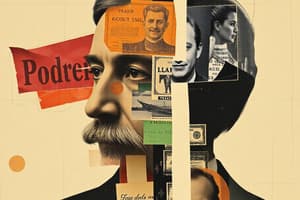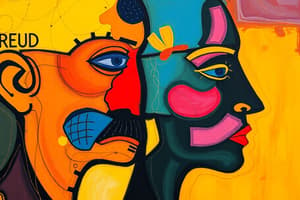Podcast
Questions and Answers
What is the main goal of therapy concerning incongruence?
What is the main goal of therapy concerning incongruence?
- Highlight the patient's irrational beliefs.
- Decrease the incongruence between self-concept and reality. (correct)
- Encourage the patient to accept their irrational thoughts.
- Increase the incongruence experienced by the patient.
Which therapy method primarily focuses on addressing the lack of logic in a patient's thinking?
Which therapy method primarily focuses on addressing the lack of logic in a patient's thinking?
- Cognitive Restructuring
- Unconditional Positive Regard
- Active Listening
- Socratic Method (correct)
What technique does Mindfulness-based Cognitive Therapy utilize to support cognitive restructuring?
What technique does Mindfulness-based Cognitive Therapy utilize to support cognitive restructuring?
- Mindfulness techniques (correct)
- Technological interventions
- Behavioral-Rehearsal
- Active Listening
Which of the following barriers to therapy is attributed to the stigma surrounding mental health?
Which of the following barriers to therapy is attributed to the stigma surrounding mental health?
In Cognitive Behavioral Theory (CBT), which aspect affects another in a cyclical manner?
In Cognitive Behavioral Theory (CBT), which aspect affects another in a cyclical manner?
What is the purpose of Unconditional Positive Regard in therapy?
What is the purpose of Unconditional Positive Regard in therapy?
What is the main focus of the Applied Behavioral Analysis approach?
What is the main focus of the Applied Behavioral Analysis approach?
What is a notable side effect of antidepressants during the initial treatment period?
What is a notable side effect of antidepressants during the initial treatment period?
What is the general function of Electroconvulsive Therapy (ECT)?
What is the general function of Electroconvulsive Therapy (ECT)?
Which of the following medications is recognized specifically as a mood stabilizer?
Which of the following medications is recognized specifically as a mood stabilizer?
Which therapy focuses on gradual exposure to phobic triggers?
Which therapy focuses on gradual exposure to phobic triggers?
What common effect can result from the use of MAOIs?
What common effect can result from the use of MAOIs?
Why is Time Delay significant in the context of antipsychotics?
Why is Time Delay significant in the context of antipsychotics?
What distinguishes a trait from a state in personality psychology?
What distinguishes a trait from a state in personality psychology?
Which of the following correctly describes Freud's concept of the superego?
Which of the following correctly describes Freud's concept of the superego?
Which statement best describes the Big Five personality trait of neuroticism?
Which statement best describes the Big Five personality trait of neuroticism?
In Jung's Analytic Theory, what is the collective unconscious?
In Jung's Analytic Theory, what is the collective unconscious?
What does the term 'comorbidity' refer to in psychology?
What does the term 'comorbidity' refer to in psychology?
Which of Freud's defense mechanisms involves attributing one's own unacceptable feelings to another person?
Which of Freud's defense mechanisms involves attributing one's own unacceptable feelings to another person?
Which of the following is a characteristic of Major Depressive Disorder?
Which of the following is a characteristic of Major Depressive Disorder?
What does the term 'helplessness theory' describe in the context of depression?
What does the term 'helplessness theory' describe in the context of depression?
Which personality assessment is known for its use of ambiguous stimuli?
Which personality assessment is known for its use of ambiguous stimuli?
What defines the 'latency stage' in Freud's psychosexual development?
What defines the 'latency stage' in Freud's psychosexual development?
Which aspect of the Big Five personality traits is associated with the willingness to try new experiences?
Which aspect of the Big Five personality traits is associated with the willingness to try new experiences?
What is considered a characteristic of a person in a manic episode?
What is considered a characteristic of a person in a manic episode?
What does Freud mean by 'regression' as a defense mechanism?
What does Freud mean by 'regression' as a defense mechanism?
What does the DSM-5 enable professionals to do?
What does the DSM-5 enable professionals to do?
Flashcards
Incongruence
Incongruence
The gap between your self-perception and reality. The bigger the difference, the more personal distress you experience.
Ecological Momentary Assessments
Ecological Momentary Assessments
Using devices like phones or smartwatches to track a patient's thoughts and behaviors in real-time.
Insight Therapies
Insight Therapies
Therapies that help people understand the reasons behind their feelings and behaviors, leading to improved psychological function.
Active Listening
Active Listening
Signup and view all the flashcards
Socratic Method
Socratic Method
Signup and view all the flashcards
Depressogenic Thinking
Depressogenic Thinking
Signup and view all the flashcards
Cognitive Restructuring
Cognitive Restructuring
Signup and view all the flashcards
Cognitive Behavioral Theory (CBT)
Cognitive Behavioral Theory (CBT)
Signup and view all the flashcards
Rational Emotive Behavioral Therapy
Rational Emotive Behavioral Therapy
Signup and view all the flashcards
Mindfulness-based Cognitive Therapy
Mindfulness-based Cognitive Therapy
Signup and view all the flashcards
Applied Behavioral Analysis
Applied Behavioral Analysis
Signup and view all the flashcards
Flooding
Flooding
Signup and view all the flashcards
Systematic Desensitization
Systematic Desensitization
Signup and view all the flashcards
Social Skills Training
Social Skills Training
Signup and view all the flashcards
States vs. Traits
States vs. Traits
Signup and view all the flashcards
Free Association
Free Association
Signup and view all the flashcards
Self-Concept
Self-Concept
Signup and view all the flashcards
Individualism
Individualism
Signup and view all the flashcards
Person-Situation Controversy
Person-Situation Controversy
Signup and view all the flashcards
Narcissism
Narcissism
Signup and view all the flashcards
Unconscious (Freud)
Unconscious (Freud)
Signup and view all the flashcards
Id (Freud)
Id (Freud)
Signup and view all the flashcards
Ego (Freud)
Ego (Freud)
Signup and view all the flashcards
Superego (Freud)
Superego (Freud)
Signup and view all the flashcards
Oral Stage (Freud)
Oral Stage (Freud)
Signup and view all the flashcards
Anal Stage (Freud)
Anal Stage (Freud)
Signup and view all the flashcards
Big Five
Big Five
Signup and view all the flashcards
Maturity Principle
Maturity Principle
Signup and view all the flashcards
Comorbidity
Comorbidity
Signup and view all the flashcards
Study Notes
Important Terms
- State: Temporary states of being.
- Trait: Long-lasting, consistent part of personality.
- Free Association: Starting with a concept or word, saying everything that comes to mind.
- Self-concept: A person's perception of themselves.
- Individualism: Trusting in oneself.
- Person-Situation Controversy: Discusses whether personality or situations are more impactful in determining a person's behavior.
Narcissism
- Pseudo Psychology (not supported): Physiognomy (physical characteristics influencing personality), and Phrenology (bumps/dents in the head).
- Four Humors: Personality determined by the balance of four bodily fluids (blood, yellow bile, black bile, and phlegm). Too much of any fluid is associated with certain personality traits (e.g., too much blood: happy).
Freud's Ideas
- Unconscious: Parts of the mind not consciously accessible. Most personality is driven by the unconscious.
- Preconscious: Thoughts not currently in awareness but accessible.
- Conscious: Currently available thoughts and active in the mind.
- Id: Part of the mind seeking to fulfill desires.
- Ego: Part of the mind that interacts with the outside world and is influenced by the Id.
- Superego: Concerned with morality and societal expectations.
Freud's Psychosexual Stages
- Oral Stage (0-18 months): Erogenous zone is the mouth. Focuses on eating and sucking.
- Anal Stage (18-36 months): Erogenous zone is the anus. Focuses on potty training.
- Phallic Stage (3-6 years): Erogenous zone is the genitals. Recognition of gender differences.
- Latency Stage (6-puberty): No erogenous zone. Repression of sexual feelings.
- Genital Stage (puberty onwards): Erogenous zone is genitals. Focused on sexual feelings and relationships.
Freud's Defense Mechanisms
- Regression: Retreating to an earlier psychosexual stage to avoid problems.
- Denial: Refusal to acknowledge reality.
- Projection: Attributing one's own feelings to another person.
- Displacement: Taking feelings out on a less threatening target.
- Reaction Formation: Expressing the opposite of what one feels.
- Rationalization: Creating excuses to justify behavior.
Freud's Ideas (Continued)
- Development: Infants develop certain capabilities at different stages.
- Dreams: Dreams are gateways to the unconscious.
- Defense Mechanisms: The ego's methods to protect itself from the unconscious and reality.
- Repression: Burying uncomfortable thoughts in the unconscious.
Big Five (Modern Theories)
- Openness: Willingness to try new things.
- Conscientiousness: Following rules and being organized.
- Extraversion: Comfort level with social interactions.
- Agreeableness: How easily one gets along with others.
- Neuroticism: Level of worry and anxiety.
Other Theories
- Rogers' Person-Centered Theory: Humans have the capacity for good. Acceptance and empathy are essential for positive growth.
Eysenck's Dimensional Theory
- Neuroticism: Emotional stability (low) or instability (high).
- Extraversion: Introversion (low) or extraversion (high).
Assessment
- Projective Tests: Given ambiguous stimuli, asked to explain it.
- Inkblot tests / Thematic Apperception Test (TAT): Interpreting ambiguous images.
- Personality Inventories: Long questionnaires to measure traits and conditions.
- Minnesota Multiphasic Personality Inventory (MMPI): A widely used personality inventory to identify personality disorders.
Psychological Disorders
- Comorbidity: Two or more disorders occurring at the same time.
- Lifetime Prevalence Rate: Probability of a disorder occurring at any point in one's life.
- Etiology: Cause of a disorder.
Abnormal Behavior
- Deviance: Unusual behavior compared to norms.
- Maladaptiveness: Behavior disrupting daily life.
- Personal Distress: Level of emotional strain.
DSM (Diagnostic and Statistical Manual)
- Diagnostic Criteria: Manual listing symptoms for each disorder, and diagnostic standards.
- Evolution of Diagnostic Methods: The DSM goes through revisions as understanding of disorders improves.
Neurodevelopmental Disorders
- Examples: Intellectual disabilities, autism spectrum disorder, and learning disorders.
- Causation: Multiple factors (genetic, environmental) can contribute to these disorders.
Depressive Disorders
- Major Depressive Disorder: Persistent depressed mood, loss of interest in activities.
- Seasonal Affective Disorder: Related to changes in seasons.
- Persistent Depressive Disorder: Chronic, low-grade depression.
Anxiety Disorders
- Generalized Anxiety Disorder (GAD): Persistent and excessive worry.
- Phobias: Intense fears of specific objects or situations.
- Obsessive-Compulsive Disorder (OCD): Obsessions and compulsions.
- Post-traumatic Stress Disorder (PTSD): Response to trauma.
- Body Dysmorphic Disorder: Unrealistic perception of flaws.
Schizophrenia
- Symptoms: Hallucinations, delusions, and disorganized thoughts and behavior.
- Types: Paranoid, disorganized, and undifferentiated, catatonic.
Bipolar Disorders
- Mania: Period with elevated mood, high energy, and impulsiveness.
- Depressive Episodes: Periods with depressed mood and loss of interest.
- Bipolar I: Marked by severe manic and depressive episodes.
- Bipolar II: Marked by hypomania and depressive episodes.
- Causes: Genetic and environmental factors.
Dissociative Disorders
- Dissociative Identity Disorder (DID): Multiple personality disorder.
- Dissociative Amnesia: Memory loss (often after a traumatic event).
- Dissociative Fugue: Memory loss and identity change with a period of travel.
- Causes: Trauma is a primary factor.
Suicide
- Geographic Differences: Differences in suicide rates across locations.
- Racial Differences: Differences in suicide rates across different racial groups. Gender Differences Men and women face different risks
Treatments for Disorders
- Importance of Rationale: Understanding why people have a disorder is key for effective treatment.
- Barriers to Therapy: Cost concerns, time constraints, and personal beliefs.
- Medication: Medications play a role in some conditions
- ECT (Electroconvulsive Therapy): Treatment used for severe cases of depression.
Specific therapies (techniques)
- Systematic Desensitization: Gradual exposure to fears.
- Social Skills Training: Training for improving social skills.
- Therapeutic Analysis: providing objective insight into a patient's behaviours.
Studying That Suits You
Use AI to generate personalized quizzes and flashcards to suit your learning preferences.




